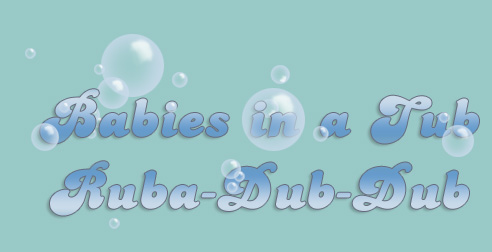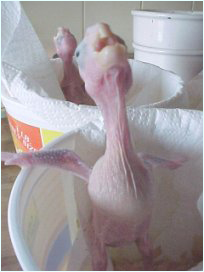 |
|
Susie Christian, Morro Bay, California
|
|
When the babies turn about three weeks, I put them into a plastic tub that is about a foot long by eight inches by about six inches deep. Most of the babies I raise are taken from their motherís nest at three to four weeks, so I donít have many babies start out in custard cups. As the babies approach six weeks, I get those bigger size Rubbermaid tubs from Kmart or Walmart that are larger across horizontally, but only about ten inches high. These tubs are usually a dark green in color, and I almost never bring the lids home with me because the tops never get used. On the very bottom of each tub I put a few layers of newspaper to absorb the liquid from the poop, and it also makes cleaning up a bit easier. After the newspaper layer on the very bottom, I put a top layer of about three inches of very coarse pine shavings. I buy my shavings at a farm supply store. There are two kinds of shavings here in California at our farm supply stores. One is called Dry Nest and those shavings are way too soft and small. Stay away from "Dry Nest" shavings. I get the big coarse shavings that are about $4.50 for a bale so large it feels like a 50 lb. sack of seed when I lift it. I also use these same shavings as nesting material for my Eclectus hens. The coarseness of the shavings is bulky enough so the hens have something to chew on and shred when they are decorating their boudoir. They are also coarse enough so the small, inquisitive babies can't get them in their mouths and the larger babies aren't focused on shavings anyway. The older babies are focused on real food and pay no heed to whatís under them. I have seen the aspen shavings, and because they are quite long and fine textured, I donít use aspen. A breeder friend says sometimes the babies scoop up a beakfull of these fine shavings, and he has had trouble with the younger babies swallowing the aspen. I never have used aspen and I can now see why I haven't. I then hang a towel over the top of the tub, covering about half the tub. This enables the babies to scoot back into the darkness, and when they are ready they can come to the front of the tub to eat and explore. I clip the towel on to the tub with large, inexpensive metal fastener clips I find at the swap meets. If the same clips are purchased at a hardware store, they are about four times the price. When I fasten the towel over the top of the tub I let the towel drape lower so it touches the babyís body. I somehow sense that it rather feels to them like a mama bird sitting over the top of them. I also add a fluffy, furry soft toy to the tub until they reach about eight weeks. This is a great idea, especially if I have a lone baby. They always cuddle up to their "Teddy" and I find them sleeping between the stuffed animalís legsÖa natural pillow for them and it looks oh so cozy too. Under the outside bottom of the tub I use a heating pad, usually turned on low or medium,depending on the age of the baby and how hot the ambient air in kitchen is. When the babies are very tiny, as I have had with the Rose breasted Cockatoos, the heating pad can be turned to high and run up one or two sides for a warm "wall" for them to cuddle against. I also found an extra long heating pad this year, which heats the whole bottom tub length and easily goes up one side. I look for heating pads at the thrift stores during the summer months so I can get a "deal" on them if possible. Thrift store price is about $3.00, where the drug store new price is about $15.00. Because the thickness of the tub is fairly heat proof, and with the additional layers of newspaper and shavings, there is no chance a baby will get burned from the high setting on the pad, placed on the *outside* of the tub only. I have seen severe crop burns from a heating pad used on the inside of a tub, and learned very well from the sad blunders of others. The poop from the babies quite handily generates its own natural humidity,which is a great side benefit. When the babies are tiny, I do spray the shavings with a small amount of water before I put the babies back in after cleaning each time, to generate more humidity. Humidity isn't quite as important as the babies grow older though and by the time they are older their poops are generous enough to do the trick! I change the tub shavings every other day and the in between day, I add about an inch or two more shavings to the top layer for cleanliness. In the past I have used towels under the babies and all it does is waste water, detergent and my time. One poop on a towel, the baby steps in it and there is an instant mess. Shavings absorb the poop better and with the natural scratching around the babies do, the shavings are constantly being reshuffled. I have also found a way to recycle shavings. I scatter them in my yard where I donít want the weeds to grow. Fresh shavings contain enough oil so I donít put them around my flowers, because they wouldnít be good for plants until they decompose for a few months at least. I can easily stack the smaller tubs on shelves in my kitchen (nursery) for the younger babies. As they get older and transfer to the large size tubs, I place two coiled rope boings that reach to the ceiling, accompanied by toys and hanging sprays of millet right above the tub. The weaning babies can come out of the tub on their own, explore the world above and outside the tub, and climb up on the boing. From the boing they can launch themselves on their first flight, which usually scares the bejeebers out of them, and they hastily return to the darkness under the towel in their still familiar tub. Whew! My tub-brooder arrangement may be primitive and simple, but I have raised several hundred assorted babies this way, and have never had one problem with its design. As a thinking, feeling human being, I absolutely hate the incessant whir of the fan motors that power commercial brooders. I think it would drive me batty if I had to listen to the fan hum continually, even on an unconscious level. I also wonder how that noise affects baby birds?? Kind of like a Chinese water torture! I tried a commercial brooder one time, and now refer to them as "death boxes". If I had to be in one of those things I would sit in the corner and wish I were dead. I feel that the Rubbermaid type tubs are the best answer. I have heard of baskets being used as a brooder arrangement, but I don't feel the weave of the basket is a good feature, because it could possibly harbor unseen "nasties" in the very weave of the basket. Also, by virtue of the open uneven weave, baskets are lots harder to clean than plastic. Many years ago I started out with cardboard boxes for my babies. Sanitation was an issue with cardboard. From there it went to aquariums but the sides are too high, making it hard to get my arms and hands in to hand feed. Then I stole a mail tub from the Post Office and it worked pretty well, but it was hard to clean. A few tubs followed me home from my last job at the pharmacy, but they had attached lids that were awkward and generally hard to clean. Rubbermaid tubs are the simplest, inexpensive, easy to clean solution for me. We ain't fancy around here but what we are is "cheep" and practical! † † Email Me Photography by Susie Christian© |


